This was published 5 years ago
John McCain, war hero, Republican senator and presidential contender
Washington: John S McCain, the proud naval aviator who climbed from depths of despair as a prisoner of war in Vietnam to pinnacles of power as a Republican congressman and senator from Arizona and a two-time contender for the presidency, died on Saturday at his home in Arizona. He was 81.
According to a statement from his office, McCain died at 4.28 pm local time. He had suffered from a malignant brain tumour, called a glioblastoma, for which he had been treated periodically with radiation and chemotherapy since its discovery in 2017.
Despite his grave condition, he soon made a dramatic appearance in the Senate to cast a thumbs-down vote against his party's drive to repeal the Affordable Care Act. But while he was unable to be in the Senate for a vote on the Republican tax bill in December, his endorsement was crucial, though not decisive, in the Trump administration's lone legislative triumph of the year.
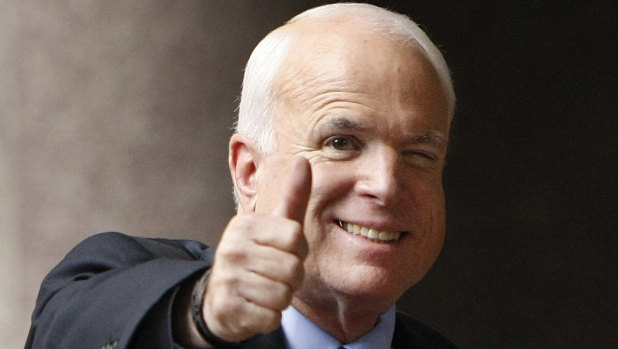
Arizona Republican Senator John McCain pictured in 2008.Credit: AP
A son and grandson of four-star admirals who were his larger-than-life heroes, McCain carried his renowned name into battle and into political fights for more than a half-century. It was an odyssey driven by raw ambition, the conservative instincts of a shrewd military man, a rebelliousness evident since childhood and a temper that sometimes bordered on explosiveness.
Nowhere were those traits more manifest than in Vietnam, where he was stripped of all but his character. He boiled over in foul curses at his captors. Because his father was the commander of all US forces in the Pacific during most of his 5 1/2 years of captivity, McCain, a Navy lieutenant commander, became the most famous prisoner of the war, a victim of horrendous torture and a tool of enemy propagandists.
Shot down over Hanoi, suffering broken arms and a shattered leg, he was subjected to solitary confinement for two years and beaten frequently.
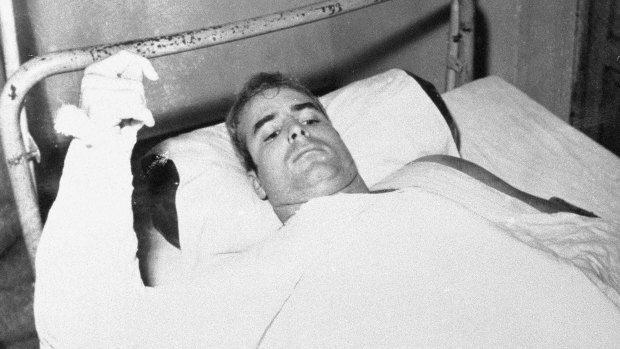
In this undated file phot , US Navy Lieutenant Commander John S McCain lies injured in North Vietnam.Credit: AP
Often he was suspended by ropes lashing his arms behind him. He attempted suicide twice. His weight fell to 45 kilograms. He rejected early release to keep his honour and to avoid an enemy propaganda coup or risk demoralising his fellow prisoners.
He finally cracked under torture and signed a "confession". No one believed it, although he felt the burden of betraying his country. To millions of Americans, McCain was the embodiment of courage: a war hero who came home on crutches, psychologically scarred and broken in body, but not in spirit. He underwent long medical treatments and rehabilitation, but was left permanently disabled, unable to raise his arms over his head. Someone had to comb his hair.
His mother, Roberta McCain, Navy all the way, inspired his political career. After retiring from the Navy and settling in Arizona, he won two terms in the House of Representatives, from 1983 to 1987, and six in the Senate. He was a Reagan Republican to start with, but later moved right or left, a maverick who defied his party's leaders and compromised with Democrats.
He lost the 2000 Republican presidential nomination to George W Bush, who won the White House.
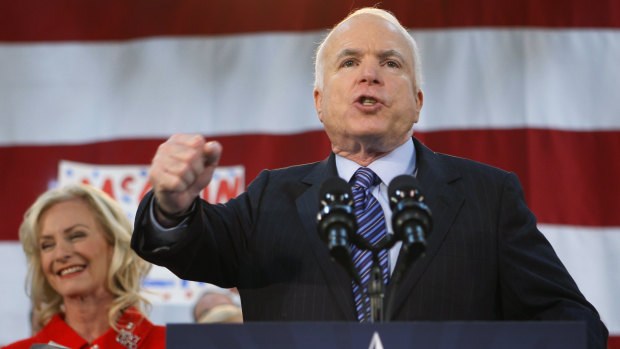
Republican presidential candidate Senator John McCain, standing with his wife Cindy, encourages his supporters to stand up and fight for America at the close of his address during a campaign rally in 2008.Credit: AP
In 2008, against the backdrop of a growing financial crisis, McCain made the most daring move of his political career, seeking the presidency against the first major-party African-American nominee, Barack Obama. With national name recognition, a record for campaign finance reform and a reputation for candour McCain won a series of primary elections and captured the Republican nomination.
But his selection of Governor Sarah Palin of Alaska as his running mate, although meant to be seen as a bold, unconventional move in keeping with his maverick's reputation, proved a severe handicap.
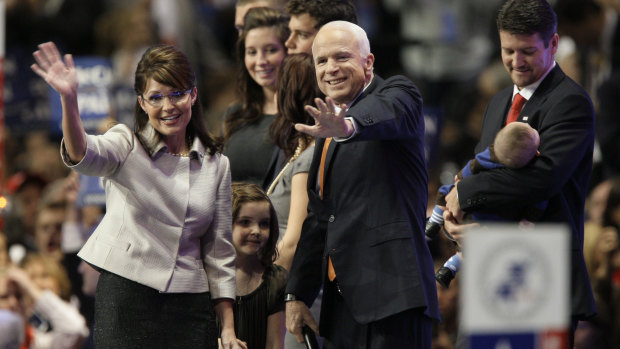
Republican presidential candidate John McCain with vice-presidential candidate Sarah Palin on the campaign trail in 2008.Credit: AP
She was the second female major-party nominee for vice-president (and the first Republican), but voters worried about her qualifications to serve as president, and about McCain's age — he would be 72, the oldest person ever to take the White House. In a 2018 memoir, "The Restless Wave: Good Times, Just Causes, Great Fights and Other Appreciations", he defended Palin's campaign performance, but expressed regret that he had not instead chosen Senator Joseph I Lieberman, a Democrat-turned-independent.
At some McCain rallies, vitriolic crowds disparaged black people and Muslims, and when a woman said she did not trust Obama because "he's an Arab", McCain, in one of the most lauded moments of his campaign, replied: "No, ma'am. He's a decent family man, a citizen that I just happen to have disagreements with on fundamental issues."
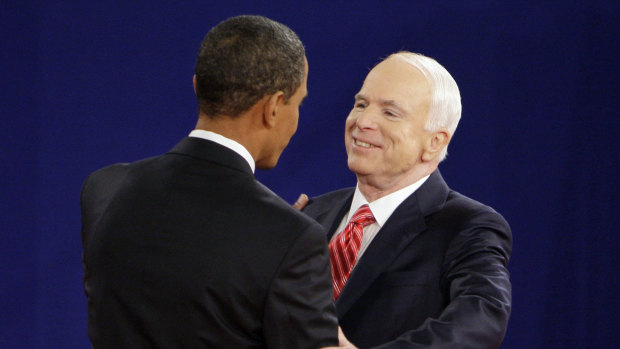
Barack Obama and John McCain greet each other at the start of a townhall-style presidential debate in 2008.Credit: AP
On Election Day, McCain lost most of the battleground states and some that were traditionally Republican. Obama won with 53 per cent of the popular vote to McCain's 46 per cent, and 365 Electoral College votes to McCain's 173.
Returning to his Senate duties, the resilient McCain moved to the right politically to fend off a Tea Party challenge to his 2010 re-election. He voted against the Affordable Care Act, Obama's signature health care plan, which became law in 2010.
As Congress reconvened in January 2015 with Republicans in control of the Senate, McCain achieved his longtime goal to become chairman of the Armed Services Committee, with the power to advance his national security and fiscal objectives under a $US600 billion military policy bill. He considered the post second only to occupying the White House as commander in chief.
With the rise of Donald Trump after his election in 2016 as the nation's 45th president, McCain was one of the few powerful Republican voices in Congress to push back against Trump's often harsh, provocative statements and Twitter posts and his tide of changes.
Personal animus between McCain and Trump arose in the Republican presidential primaries in 2016. McCain and Mitt Romney, with standing as the previous two Republican presidential nominees, denounced Trump as unfit for the presidency.
Saying Trump had neither the temperament nor the judgment for the White House, McCain and Romney called him ignorant on foreign policy and said he had made "dangerous" statements on national security.
In a venomous response, Trump denigrated Romney as a "failed candidate" and "a loser" beaten by Obama. He had little to say about McCain. But months earlier, Trump, who had never served in the military (or held public office) had derided McCain as a bogus war hero and made light of his years of captivity and torture.
"He's a war hero because he was captured," Trump said. "I like people who weren't captured."
McCain held his fire. But the nation was shocked.
McCain voted for all but two of Trump's 15 Cabinet selections and eight other administration posts requiring Senate confirmation. But he also chastised Trump for comments equating Russian and U.S. interests. "That moral equivalency is a contradiction of everything the United States has ever stood for in the 20th and 21st centuries," he said.
To the Navy born
John Sidney McCain III was born on August 29, 1936, at the Coco Solo Naval Air Station in the Panama Canal Zone, one of many posts where his father, John Sidney McCain Jr, served in a long, distinguished Navy career. He was the middle sibling of three children. His mother, born Roberta Wright, was a California oil heiress.
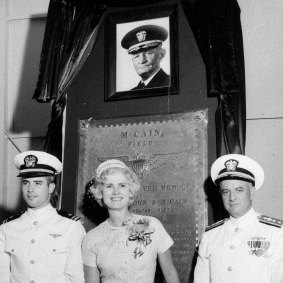
In this July 14, 1961, file photo, US Navy Lieutenant Commander John S McCain III, left, and his parents, Rear Admiral John S McCain Jr, right, and Roberta Wright McCain stand in front of a plaque with an image of his grandfather, Admiral John S McCain, at the Naval Air Station Meridian McCain Field in Mississippi. Credit: AP
With his older sister, Jean Alexandra (who was known as Sandy), and brother, Joseph Pinckney McCain II, John grew up with frequent moves, an often-absent father, a rock-solid mother and family lore that traced ancestral lineages to combatants in every US war and to Scottish clans.
Whipsawed by family relocations, young John attended some 20 schools before finally settling into Episcopal High School, an all-white, all-boys boarding school in Alexandria, Virginia, in the autumn of 1951 for his last three years of secondary education.
But the scion of one of the Navy's most illustrious families was defiant and unruly. He mocked the dress code by wearing dirty blue jeans. He was cocky and combative.
He graduated in 1954.
That summer, he followed his father and grandfather into the US Naval Academy in Annapolis, Maryland.
In 1958, he graduated 894th in his class, fifth from the bottom. Accepted for flight training, the newly commissioned Ensign McCain learned to fly attack jets at the Naval Air Station in Pensacola, Florida.
In 1965, McCain married Carol Shepp, a model. He adopted her two children, Douglas and Andrew, and they had a daughter, Sidney. After a long separation, the couple were divorced in 1980. He then married Cindy Lou Hensley, a Phoenix teacher whose father owned a beer distributorship. They had two sons, John IV and James, and a daughter, Meghan, and adopted a girl, Bridget, from a Bangladeshi orphanage.
A complete list of survivors was not immediately provided.
Promoted to lieutenant commander in early 1967, McCain requested combat duty and was assigned to the carrier Forrestal, operating in the Gulf of Tonkin. Its A-4E Skyhawk warplanes were bombing North Vietnam. He flew five missions.
On October 26 he took off on his 23rd mission of the war, part of a 20-plane attack on a heavily defended power plant in central Hanoi. Moments after releasing his bombs on target, as he pulled out of his dive, a Soviet-made surface-to-air missile sheared off his right wing.
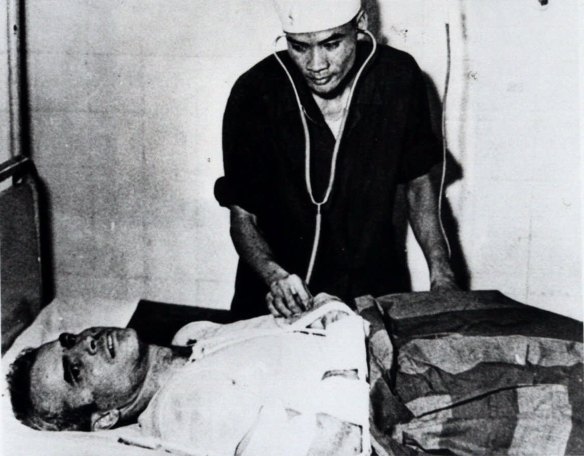
John McCain, as a prisoner of war, in a Hanoi hospital in 1967. Credit: AP
He ejected as the plane plunged, but hit something as he exited. Both arms were broken and his right knee was shattered. He fell into a lake and, with 20 kg of gear, sank 5 metres to the bottom, then pulled the inflating pins of his Mae West life jacket with his teeth and rose to the surface, gasping for air. Swimmers dragged him ashore, where he was set upon by a mob.
McCain was stripped to his skivvies, kicked and spat upon, then bayonetted in the left ankle and groin. A North Vietnamese soldier struck him with his rifle butt, breaking a shoulder. Carried to a truck, McCain was driven to Hoa Lo, the prison compound its American inmates had labelled the Hanoi Hilton.
There he was denied medical care. His knee swelled to the size and colour of a football. He lapsed in and out of consciousness for days. When he awoke in a cell infested with roaches and rats, he was interrogated and beaten.
After two weeks, a doctor, without anaesthesia, tried to set his right arm, broken in three places, but gave up in frustration and encased it in a plaster cast. He was moved to another site and tended by two American prisoners of war, who brought him back from near death.
Only after his captors learned that his father was an admiral was he given a modicum of medical treatment.
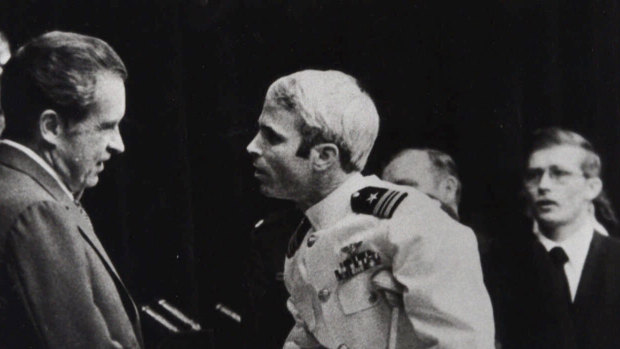
In this May 25, 1973, file photo, US Navy Lieutenant Commander John McCain is greeted by President Richard Nixon, left, in Washington, after McCain's release from a prisoner of war camp in North Vietnam. Credit: AP
In March 1968, McCain was put in solitary confinement, fed only watery pumpkin soup and scraps of bread. It lasted two years. When Admiral McCain became the Pacific Theatre commander in July, his son was offered early repatriation repeatedly. McCain refused, following a military code that prisoners were to be released in the order taken. He was beaten frequently and tortured with ropes.
Years after his confession to "war crimes" and "air piracy," McCain wrote: "I had learned what we all learned over there: that every man has his breaking point. I had reached mine."
His ordeal finally ended on March 14, 1973, two months after the Paris Peace Accords had ended US involvement in the war. He went home a celebrity.
For a Navy man who had always tried to live up to his father's accomplishments, the Silver and Bronze stars, the Distinguished Flying Cross and other decorations he received were not enough. But a psychiatrist's report seemed to capture his happiest moment. "Felt fulfillment," it said, "when his dad was introduced at a dinner as 'Commander McCain's father.'"
New York Times